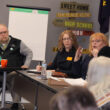Audrey Caro
The Sweet Home City Council unanimously approved an intergovernmental agreement with the Oregon Department of Transportation at a special meeting on Aug. 28.
Councilor James Goble was absent.
The agreement, referred to as the Multimodal Transportation Enhancement Program, is to construct a multi-use path, sidewalks and bike lanes along Highway 20 from 54th Avenue to Riggs Hill Road, across from the Shea Point rest area, in the city of Sweet Home.
The matter was on the agenda of the Aug. 22 meeting for council action.
In a request for council action on the Aug. 22 agenda, city staff engineer Joe Graybill offered three options to councilors: reject the agreement and cancel the project, reject the agreement and re-apply for an additional grant, or accept the local agency agreement and authorize the agreement.
Graybill offered some background.
“As part of a major 3R roadway improvement to Main Street by ODOT in 1999, the sidewalks being constructed stopped short of the east city limits – Riggs Hill Road/Shea Point – at 54th Avenue in Foster,” Graybill said. “…The active railroad trestle was a design constraint to sidewalks continuing eastward. Consultations with ODOT, the (Army Corps of Engineers), and (Albany & Eastern Railroad) over the years have morphed into a sidewalk accessibility plan that can provide east-west access and serve many customers.”
In 2012, Sweet Home Engineering staff applied to the ODOT Statewide Transportation Improvement Program grant process to fund sidewalks, safe crossings, parking, and a wide shoreline multi-use path that connected from an existing one off 60th Ave eastward to the USACOE Shea Point Overlook, Graybill said.
That project was approved on December 18, 2014.
Councilors did not make a decision at the Aug. 22 meeting; they had more questions.
City Manager Ray Towry invited Brennan Burbank, local project delivery coordinator from ODOT, to answer those questions.
“One thing in my conversation with Brennan is there is a little bit of time constraint as far as funding is concerned and ODOT needs an answer on this, preferably by this week,” Towry said.
Burbank started by saying that no funds were at risk for the project if councilors decided not to sign the IGA.
“I see this as something that you as the city are doing a favor for ODOT in signing this IGA, this first IGA, with later following up with an amendment to subtract some funds,” Burbank said.
“By signing the IGA, the city agreed to depositing $25,880.40 in the month of September toward the design phase of the enhanced project,” he said.
The original amount that was funded was $1.8 million dollars including a Sweet Home match of $523,535.
“When Joe (Graybill) submitted the application for the enhanced program, the original project was for $2.9 million,” Burbank said. “Once we started digging into this 10 months ago, we looked at the awarded amount compared to what was applied for. Obviously, there’s a big difference there – a $1.1 million difference.”
The revised total project cost $2,168,087 but with more federal and state funds, Sweet Home’s match amount is $299,534.51.
Burbank said the revised project does not include two portions that they could apply for federal funds for later, including a portion of the path and “a broad access stairway down into the water and below the water level so that as it fluctuates in the summer, people can still come from the pathway to that area (at the north shore of Foster Dam,” Graybill said.
Councilor Lisa Gourley asked if that project could be phased in later, to which Graybill responded yes. She also asked for the cost of that project. Graybill did not have that amount immediately available.
Burbank estimated about $300,000.
Mayor Greg Mahler asked who would be responsible for maintenance of the stairs.
Graybill said that is a good question for the future.
Councilor Dave Trask said the city would be responsible.
“We serve the public and frankly, we should have public access to that lake,” Gourley said.
Burbank said he and a colleague would be more than willing to help with the application for Federal Lands Access Program dollars that would pay for that.
The city plans to install two pedestrian walkways, near 49th and near 40th avenues, with $141,587 from federal earmark dollars. Burbank contacted someone with the Sidewalk Improvement Program Funds (SWIP) for an additional $450,000 toward the project.
It is a crosswalk with an offset center, in the center lane to offer a pedestrian refuge, Graybill said.
“It’s not the push-button reflective rapid-flasher beacon,” Graybill said. “Those are better at slower-speed environments, like 25-mile-an-hour zone, for example.”
In higher speed zones, you don’t want people coming to a stop, he added.
“The emphasis to caution is to the pedestrian, not to the driver,” Graybill said. “The reason being that if the beacon is there in a 45-mile-an-hour speed zone, people are traveling at 45 to 50-ish, you have somebody stopped, as they should for a pedestrian, the people behind you, they might be paying attention, so they would stop also. Well at 45-mile-an-hour, that’s a high-speed rear-end crash.”
Councilor Diane Gerson expressed concern about part of the contract that states ODOT can award a construction contract that is 10 percent over the estimate without getting the city’s approval, but the city is still obligated to pay it.
Burbank said that is standard with IGAs.
“From my perspective, I want to make sure that we don’t have any overrides because we don’t have any money,” Gerson said. “Putting this kind of money into sidewalks, my personal thing is that I’m not happy about it. I like the project, but from a citywide perspective, you know we need a lot of road maintenance.
“But as long as we can be assured that ODOT will be very conservative in their approach to the construction phase of it, and keep those overrides either nonexistent or at least minimal, then…”
Burbank said they can always reduce the scope of the project to fit within the budget.
“There are things built in throughout the process that will allow us to keep tabs on where the expenditures are going,” Towry said.
The city has the ability to work with ODOT and make adjustments to the project.
“Further, we make payments in chunks, so we’ll be able to monitor as we go,” Towry said. “If our first chunk ends up being way more than we thought it would be, we know we’ve got to start making adjustments on he back end of the project.”
He said construction is not starting tomorrow, so that gives the city time to forecast expenditures and to collect revenues, including at least one year’s worth of gas tax.
“We’ll have at least a budget cycle to take those funds and contribute if we need to, or to say nope, we’re sticking with what we’ve got,” Towry said.




